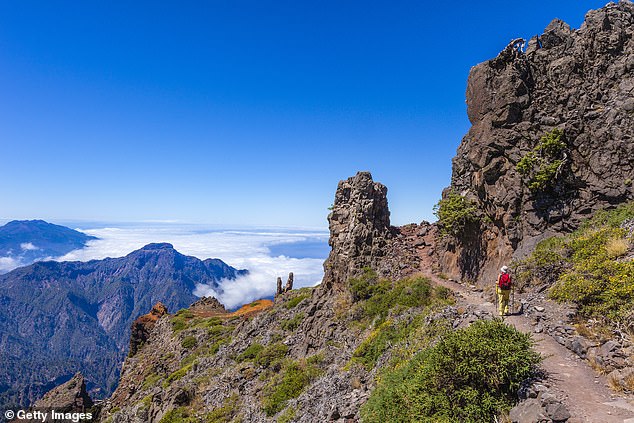My breathtaking walking holiday on La Palma amid active volcanoes and a starry sky – it was lava at first sight!

The wind blows loose cinders from the enormous hump of this naked gray mountain, cut through by red gullies. I look in disbelief and remind myself of a ridiculous fact: this entire mountain has yet to celebrate its third birthday.
For 86 days ending in December 2021, the Tajogaite (‘cracked mountain’) volcano thundered into existence as it spewed ash and rivers of lava across the lush Aridane Valley below. Houses, roads, fields and banana plantations were swallowed whole.
“Sensational doesn’t come close to what we saw,” said Simon Orr-Ewing, a Canadian resident of La Palma who has a permit to guide groups to this otherwise remote area of living volcanic activity. ‘But it was brutal and devastating. More than 7,000 people had to be evacuated.’
To reach our vantage point, we had followed Simon along a path through hardened ash lined with chunks of pumice. Treetops and chimneys poked through the destroyed ground.
My wife Hennie and I are following La Palma’s Volcanic Trails route for a week, put together by hiking specialist Inntravel, to admire the island’s amazing newborn landscapes. We stay in three small hotels, between which we walk with luggage that is transferred by taxi.

Rock star: Martin Symington and his wife travel to La Palma (pictured), where they join Inntravel’s Volcanic Trails route, walking between hotels to take in the Canary Island landscape
Even before the eruptions temporarily closed the island to visitors, La Palma was a less visited Canary Island. There are few beaches or hotels and negligible nightlife. Instead, it attracts niche markets such as hikers, nature lovers and stargazers.
The fact that La Palma is not particularly easy to reach is a plus. We get there via a propeller plane from neighboring Tenerife. It’s lava at first glance: a chunk of jagged rock, draped in a ragged green scarf, adrift in the white-capped Atlantic Ocean. La Palma rises to a volcanic cone higher than Ben Nevis with Snowdon on top.
Our first stay is in airy little Santa Cruz, the main town, which was an important port during the time of the Spanish Empire. We find tree-shaded squares and pastel-colored houses with wooden balconies that could be in colonial Colombia.

Martin walks to the Tajogaite volcano (seen here), which erupted on the Spanish island in 2021. “It was brutal and devastating,” said Simon Orr-Ewing, a Canadian resident of La Palma. ‘More than 7,000 people had to be evacuated’

Above, a sign next to Tajogaite Volcano points hikers to several points of interest. “One thing about volcanic islands is the variety of terrain,” says Martin
One thing about volcanic islands is the variety of terrain. Over the next few days we navigate through dizzyingly deep valleys divided into small plots of avocados and dragon trees, emerging into undergrowth dotted with prickly pears. We dive into the lichen-covered laurel forest, littered with the cones of the eruptive past.
This last walk leads us to Las Indias near the southern tip. On what is our most physically taxing day, we circle high above the steep coastline and then descend suddenly as the sea continues to grow.
Beyond Las Indias we arrive at enormous flows of magma that were discharged from the El Charco and San Juan volcanoes in 1712 and 1949 respectively. Our footsteps crackle and pop along a black cinder path. The bare lava makes me feel like an ant on the side of an elephant. A side path reveals coves with waves breaking on bizarre black sculptures of solidified lava.

Along the way, Martin stays in Santa Cruz (photo), the main city of La Palma. “We find squares with trees and pastel-colored houses with wooden balconies that could be in colonial Colombia,” he writes

Martin describes La Palma, pictured here, as a ‘piece of jagged rock, draped with a ragged green scarf, adrift in the white-capped Atlantic Ocean’
The final stretch to our destination in the town of Llanos de Aridane is by car along a new road bulldozed through the wasteland of the 2021 eruption. As our eyes follow thick octopus tentacles of lava towards Tajogaite, I am reminded that geography and geology are not history on an active volcano; they happen before your eyes.
I mentioned stargazing. With a clear atmosphere and light pollution kept to a minimum by law, La Palma is one of the best places on earth to view the sky. So on our last evening, with astronomer Elena Nordio from Ad Astra, we corkscrew up to the Llano del Jable viewpoint.
Through Elena’s telescope we are impressed by Jupiter and its moons, the Orion Nebula and the hazy Andromeda Galaxy. Have I written before that La Palma has a negligible nightlife? Sorry, scrub that. With chunks of lava down below and diamonds in the sky, the nightlife is out of this world.




